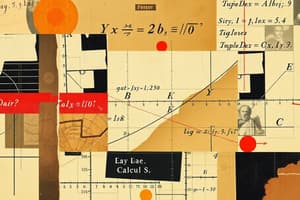Podcast
Questions and Answers
What mathematical concept calculates the rate at which a function changes with respect to a variable?
What mathematical concept calculates the rate at which a function changes with respect to a variable?
- Derivative (correct)
- Coefficient
- Integration
- Functionality
In calculus, what does 'f'(x) represent?
In calculus, what does 'f'(x) represent?
- The area under the curve
- The slope of the tangent line (correct)
- The value of x
- The function at x=0
Which symbol is commonly used to represent a small change in a function?
Which symbol is commonly used to represent a small change in a function?
- dx (correct)
- dy
- dt
- dz
What does the differential 'df' help approximate in a function?
What does the differential 'df' help approximate in a function?
What becomes more accurate as the size of the differential 'dx' decreases?
What becomes more accurate as the size of the differential 'dx' decreases?
Flashcards are hidden until you start studying
Study Notes
Calculus Diferencial: A Deep Dive into Derivatives and Differentials
Calculus Diferencial, or simply Calculus as it's commonly known, is a branch of mathematics that deals with rates of change, accumulation, and the properties of functions. The primary focus of Calculus Diferencial lies in the study of derivatives and differentials.
Derivatives
Derivative is a mathematical concept that calculates the rate at which a function changes with respect to a variable, often represented by the symbol "f'(x)" or "df/dx". A derivative shows how quickly a function increases or decreases at a given point.
For instance, let's consider a function f(x) = 3x^2 + 7x + 1. The derivative of this function, f'(x), would be:
f'(x) = 6x + 7
The derivative function, f'(x), represents the slope of the tangent line to the original function at any point.
Differentials
Differential is a small change in a function, represented by the symbol "dx" or "df." Differentials are used to approximate small changes in a function, and they become more accurate as the size of the change decreases.
For example, if we have a function f(x) = 3x^2 + 7x + 1, and we wish to find the change in the function when x changes from x to x + dx, we can calculate the differential as:
df = f'(x) * dx
As the size of the differential "dx" decreases, the approximation becomes more accurate.
Applications of Calculus Diferencial
Calculus Diferencial has a wide range of applications, including:
- Physics: Calculating rates of change (velocity, acceleration), force, energy, and more.
- Chemistry: Calculating reaction rates and concentrations.
- Economics: Calculating demand, supply, and growth rates.
- Engineering: Calculating stress, strain, and displacement.
- Biology: Calculating population growth rates and drug concentrations.
Calculus Diferencial is a fundamental branch of mathematics that underlies the study of many other subjects and serves as a foundation for further mathematical developments. With its powerful tools for finding rates of change and approximating values, Calculus Diferencial is an essential skill for students and professionals alike.
Studying That Suits You
Use AI to generate personalized quizzes and flashcards to suit your learning preferences.




